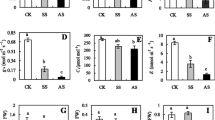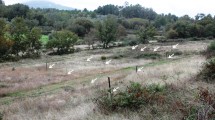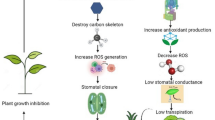Abstract
Water deficit is an important yield-decreasing factor in winter wheat (Triticum aestivum L.). Normally, it has been hypothesized that plants under water deficit suffer from carbon (C) shortage and their growth is thus limited. In this study, the changes in plant growth and carbohydrate metabolism during wheat adaptation to water deficit were investigated. The results showed that water deficit induced a decrease in stomatal conductance and transpiration as early avoidance responses to water deficit. Mild deficit stimulated lateral root development, thus facilitating water uptake. While leaf relative expansion rate was decreased more than photosynthesis, water deficit leads to a more positive C balance. Carbohydrate metabolites measured (starch and sugars) showed a diurnal turnover that often increased under mild water deficit suggesting that these metabolites were readily available for being metabolized in source organ or exported to roots. The relative growth rate in mild deficit plants was higher than that in well-watered treatment, although leaf growth was decreased. Water deficit induced a shift of metabolism enzymes activities that was indicative of increased, rather than decreased, C availability. These results showed that wheat seedlings exhibited fast acclimation to changes in environmental conditions which results in an increased availability of C for the roots, and increased turnover of C metabolites. Mild water deficit increased water use efficiency through increasing dry matter production and saving water use.






Similar content being viewed by others
References
Agbicodo EM, Fatokun CA, Muranaka S, Visser RGF, van der Linden CG (2009) Breeding drought tolerant cowpea: constraints, accomplishments, and future prospects. Euphytica 167:353–370
Ainsworth EA, Bush DR (2011) Carbohydrate export from the leaf: a highly regulated process and target to enhance photosynthesis and productivity. Plant Physiol 155:64–69
Asseng S, Ritchie JT, Smucker AJM, Robertson MJ (1998) Root growth and water uptake during water deficit and recovering in wheat. Plant Soil 201:265–273
Barrs HD (1968) Determination of water deficit in plant tissues. In: Kozlouski TT (ed) Water deficits and plant growth, vol I. Academic Press, New Delhi, pp 235–268
Chaves MM (1991) Effects of Water Deficit on Carbon assimilation. J Exp Bot 42:1–16
Chaves MM, Pereira JS, Maroco J, Rodrigues ML, Ricardo CP, Osorio ML, Carvalho I, Faria T, Pinheiro C (2002) How plants cope with water stress in the field. Photosynth Growth. Ann Bot 89:907–916
Chaves MM, Flexas J, Pinheiro C (2009) Photosynthesis under drought and salt stress: regulation mechanisms from whole plant to cell. Ann Bot 103:551–560
Dhanda SS, Sethi GS, Behl RK (2004) Indices of drought tolerance in wheat genotypes at early stages of plant growth. J Agron Crop Sci 190:6–12
Flexas J, Medrano H (2002) Drought-inhibition of photosynthesis in C3 plants:stomatal and non-stomatal limitation revisited. Ann Bot 89:183–189
Galle A, Feller U (2007) Changes of photosynthetic traits in beech saplings (Fagus sylvatica) under severe drought stress and during recovery. Plant Physiol 131:412–421
Ghannoum O, Conroy JP, Driscoll SP, Paul MJ, Foyer CH, Lawlor DW (2003) Nonstomatal limitations are responsible for drought induced photosynthetic inhibition in four C4 grasses. New Phytol 159:599–608
Gibon Y, Usadel B, Blaesing OE, Kamlage B, Hoehne M, Trethewey R, Stitt M (2006) Integration of metabolite with transcript and enzyme activity profiling during diurnal cycles in Arabidopsis rosettes. Genome Biol 7:R76
Hanson J, Smeekens S (2009) Sugar perception and signaling-an update. Curr Opin Plant Biol 12:562–567
Hu MY, Shi ZG, Zhang ZB, Zhang YJ, Li H (2012) Effects of exogenous glucose on seed germination and antioxidant capacity in wheat seedlings under salt stress. Plant Growth Regul 68:177–188
Husen A, Iqbal M, Aref IM (2014) Growth, water status, and leaf characteristics of Brassica carinnata under drought and rehydration conditions. Braz J Bot 37:217–227
Izanloo A, Condon AG, Langridge P, Tester M, Schnurbusch T (2008) Different mechanisms of adaptation to cyclic water stress in two South Australian bread wheat cultivars. J Exp Bot 59:3327–3346
Kalwade SB, Devarumath RM (2014) Functional analysis of the potential enzymes involved in sugar modulation in high and low sugarcane cultivars. Appl Biochem Biotechnol 172:1982–1998
Keunen E, Peshev D, Vangronsveld J, Ende WVD, Cuypers A (2013) Plant sugars are crucial players in the oxidative challenge during abiotic stress: extending the traditional concept. Plant, Cell Environ 36:1242–1255
Kim JY, Mahe´ A, Brangeon J, Prioul JL (2000) A maize vacuolar invertase, IVR2, is induced by water stress: organ/tissue specificity and diurnal modulation of expression. Plant Physiol 124:71–84
Lynch JP (2007) Roots of the second green revolution. Aust J Bot 55:493–512
Misra AN, Biswal AK, Misra M (2002) Physiological, biochemical and molecular aspects of water stress responses in plants, and the biotechnological applications. Natl Acad Sci, India B 72:115–134
Neumann P (1995) The role of cell wall adjustment in plant resistance to water deficits. Crop Sci 35:1258–1266
Peng M, Gao M, Abdel-Aal ESM, Hucl P, Chibbar RN (1999) Separation and characterization of A- and B-type starch granules in wheat endosperm. Ceareal Chem 76:375–379
Ramel F, Sulmon C, Gouesbet G, Couee I (2009) Natural variation reveals relationships between pre-stress carbohydrate nutritional status and subsequent responses to xenobiotic and oxidative stress in Arabidopsis thaliana. Ann Bot 104:1323–1337
Rosegrant MW, Cline SA (2003) Global food security: challenges and policies. Science 302:1917–1919
Salekdeh GH, Reynolds M, Bennett J, Boyer J (2009) Conceptual framework for drought phenotyping during molecular breeding. Trends Plant Sci 14:488–496
Sulpice R, Pyl ET, Ishihara H, Trenkamp S, Steinfath M, Witucka-Wall H (2009) Starch as a major integrator in the regulation of plant growth. Proc Natl Acad Sci USA 106:10348–10355
Valliyodan B, Nguyen HT (2006) Understanding regulatory networks and engineering for enhanced drought tolerance in plants. Curr Opin Plant Biol 9:1–7
Villadsen D, Rung JH, Nielsen TH (2005) Osmotic stress changes carbohydrate partitioning and fructose-2,6-bisphosphate metabolism in barley leaves. Funct Plant Biol 32:1033–1043
Zhang Q (2007) Strategies for developing green super rice. Proc Natl Acad Sci USA 104:16402–16409
Zhou Q, Yu YJ (2010) Changes in content of free, conjugated and bound polyamines and osmotic adjustment in adaptation of vetiver grass to water deficit. Plant Physiol Biochem 48:417–425
Zhou X, Yan Y, Wan Ch, Wang H, Wu L, Wang Y, Ren J (2010) Effects of film-bottomed treatment on seedling emergence and growth of Caragana korshinskii in arid northwestern China. Plant, Soil Environ 56:186–193
Zrenner R, Stitt M (1991) Comparison of the effect of rapidly and gradually developing water-stress on carbohydrate metabolism in spinach leaves. Plant Cell Environ 14:939–946
Acknowledgments
This work was supported by the grant from Knowledge Innovated Engineering of the Chinese Academy of Sciences (KSCX2-EW-N-02), Natural Science Foundation of Hebei (C2013301057) and Ministry of Agriculture, major projects transgenic (2014ZX08002005). Many thanks are given to my worker mates for assistance in technical and useful comments.
Author information
Authors and Affiliations
Corresponding author
Additional information
MengYun Hu and ZhiGang Shi contributed equally to this work and should be regarded as co-first authors.
Rights and permissions
About this article
Cite this article
Hu, M., Shi, Z., Xu, P. et al. Wheat acclimate to water deficit by modifying carbohydrates metabolism, water use efficiency, and growth. Braz. J. Bot 38, 505–515 (2015). https://doi.org/10.1007/s40415-015-0169-3
Received:
Accepted:
Published:
Issue Date:
DOI: https://doi.org/10.1007/s40415-015-0169-3




